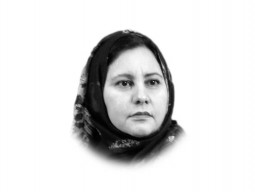
Arzoo Raja was declared by medical experts to be no more than 14 years’ old. Her parents held NADRA records that recorded her age at 13. Her husband, and alleged kidnapper, was 40 years’ old. In Sindh, marriage before the age of 18 is a crime, meaning that her husband can be sent to jail.
Despite all of this, if it is found that Arzoo married of her own free will, then, the marriage cannot be declared invalid under any law in Pakistan. This is because under the predominant interpretation of Muslim Personal Law in the country once a girl reaches puberty she is deemed to be competent to marry.
Arzoo’s tragedy does not end here. Children like Arzoo stand at the intersection of oppression in Pakistan: female and a member of a minority religious faith.
Arzoo’s parents allege that she was kidnapped, forced to convert to the Muslim faith from Christianity, and married to her kidnapper. However, despite her age, no law declares her conversion to be invalid. This is not an isolated story. Reports by multiple groups indicate that thousands of minor girls from religious minorities are subjected to the same treatment every year.
Despite repeated attempts to legislate on the issue of forced conversions, no actual legislation has been passed. Last year, the PPP rejected a proposed bill in the Sindh Assembly that would have prevented a change in religion before the age of 18. A similar proposal was rejected in 2016.
And so, women from religious minorities are faced with a double dose of oppression. Abducted, coerced into changing their religion, coerced into marriages with their kidnappers, and then forgotten by a legal system that makes grand promises of religious liberty and human dignity.
What prevents us from protecting one of the most vulnerable groups of children in our country? Like many problems in this country, the power of conservative religious groups.
The Council of Islamic Ideology (CII) has ruled that marriage cannot be limited to any age apart from puberty under Islam. Similarly, they have viewed any cap on the age at which someone can change their faith to be against the principles of Islam.
There are two problems with this view: first, when this principle of Muslim Personal Law was established the average age of puberty used to be between the ages of 16 to 18 years. It is only recently that the age of puberty has decreased due to changes in diet and health. Second, a stubborn view of when someone can convert to a different religion ignores context, such as how susceptible children are to manipulation.
The CII, and others who oppose changes in the law, would claim that consent is the sole consideration to take into account in these cases. If a child is coerced the marriage and the conversion should be declared invalid.
Yet, it has proved to be extremely difficult to demonstrate lack of consent in most cases of child marriage or forced conversion. Minor girls who are abducted are often subjected to physical and mental abuse to compel them to sign affidavits claiming that they did everything through their own free will. The truth of these statements is often not probed by the courts. Furthermore, while cases proceed, courts often send the young women back to their husbands in the interim rather than shelter homes.
In some cases, like Arzoo’s, the child is asked in court if they were coerced or if they acted freely. Often, the child says they did everything of their own volition. But we cannot take these statements independent of context. A child who has left her faith, married, had the marriage consummated, and publicly called out for all of this has little choice in this society but to say that it was all her own doing.
Let’s however, for the sake of argument, assume that these children consent of their own free will to change their faith and marry men twice their age. Why do we forget in these scenarios that these are children we are talking about? Children who are not supposed to be able to consent to such drastic and life altering decisions and commitments. Children can be groomed, children can be manipulated, and children can be made to commit to decisions that will ruin their lives. We need law that overrides this consent.
There is another aspect in the story that we cannot ignore and which questions whether we can ever have true consent in these scenarios.
Most religious minorities in Pakistan face economic and social exclusion. A large portion of them in Sindh are subjected to bonded labour. Young girls from these families are enticed with promises of freedom from this form of slavery if they convert to the majority faith and marry older men. In fact, conversion to Islam has now become the last hope for religious minorities who crave social and economic uplift. “What we are seeking is social status, nothing else,” said Muhammad Aslam, to The New York Times. Aslam used to belong to the Hindu faith before he converted along with his family. “These conversions are becoming very common in poor Hindu communities.”
Is this how Pakistan wishes to spread the faith that states that there is no compulsion in religion? By social and economic oppression?
Consent is therefore not the saviour in these cases that it is made out to be. A child should not be able to consent to marriage or to changing their faith — it is about time that our law catches up with the rest of the world on this.
Pakistan has committed to eliminating the practice of child marriage by 2030 in line with UN Sustainable Development Goals. However, as the facts show, there is no concrete plan for achieving this. We will need not only law, but a change in the social and economic life of our religious minorities. Until then, their children are not safe.
Published in The Express Tribune, November 17th, 2020.
Like Opinion & Editorial on Facebook, follow @ETOpEd on Twitter to receive all updates on all our daily pieces.



1719211536-0/BeFunky-collage-(81)1719211536-0-165x106.webp)





1729685382-0/Untitled-design-(57)1729685382-0-270x192.webp)











COMMENTS
Comments are moderated and generally will be posted if they are on-topic and not abusive.
For more information, please see our Comments FAQ